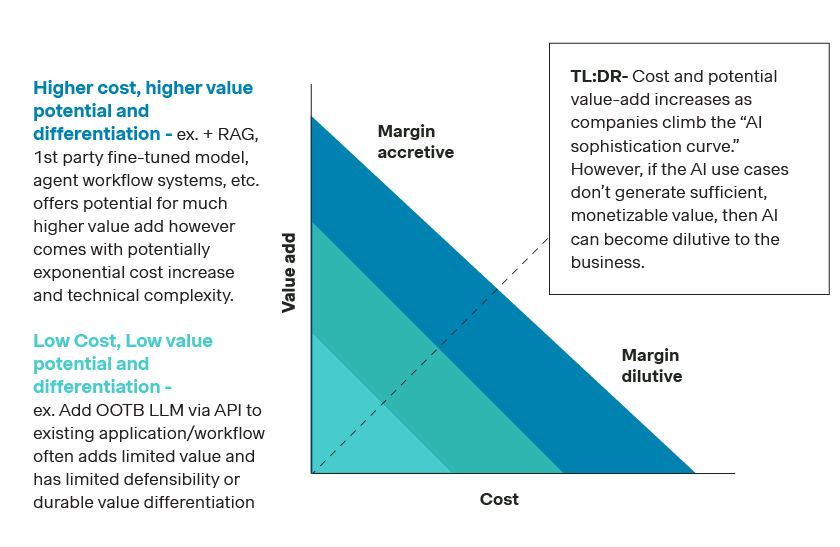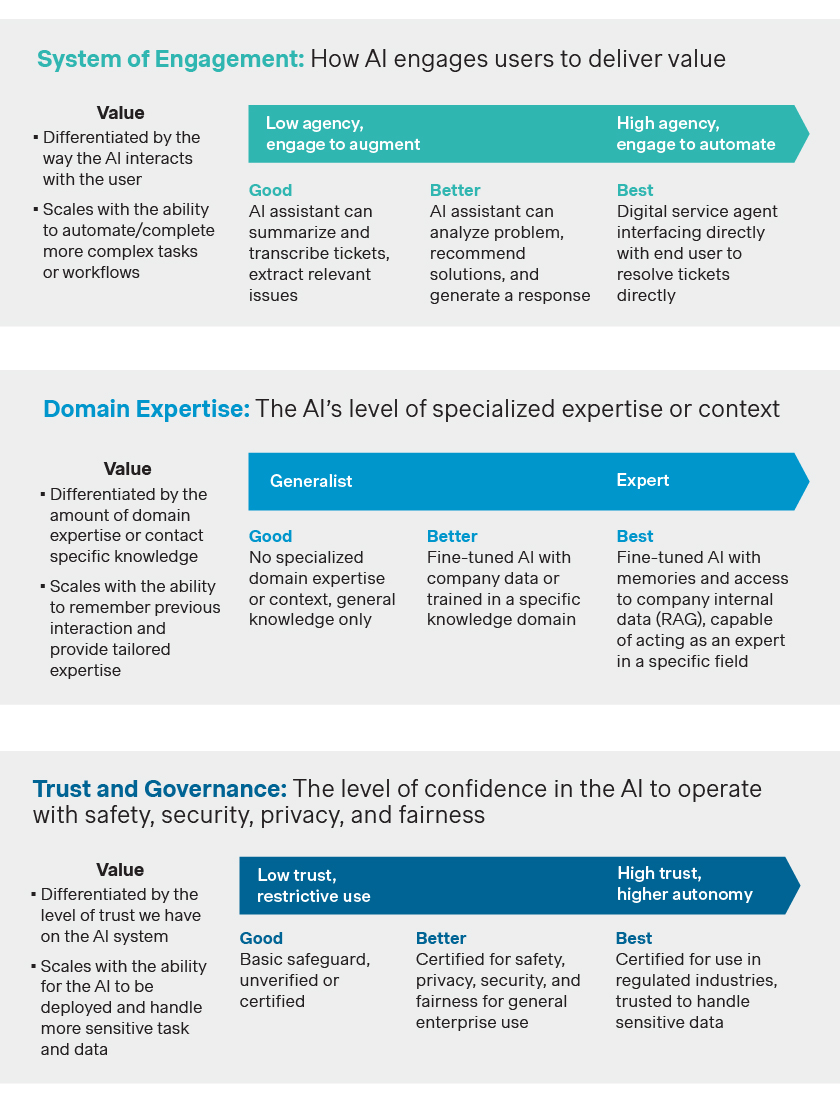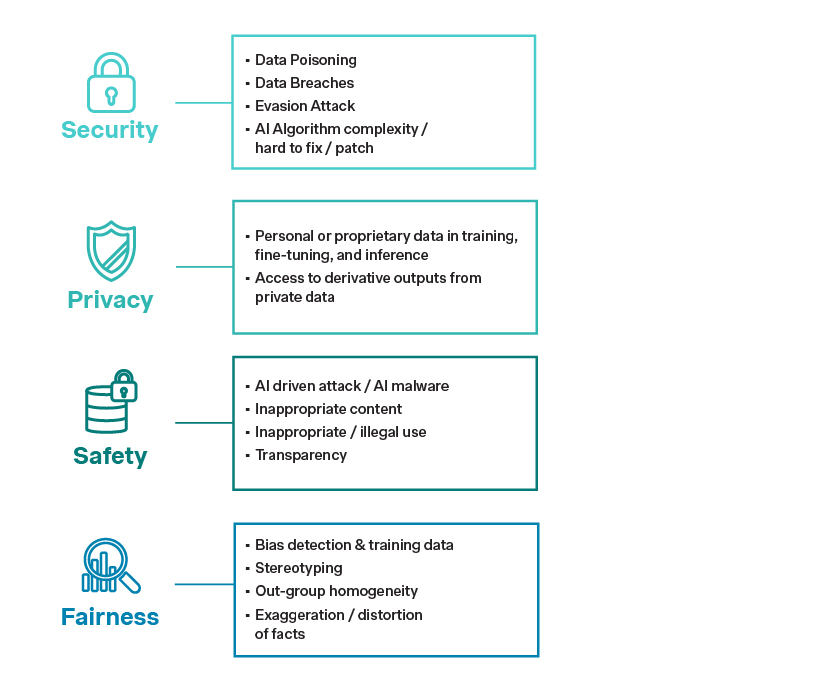Co-authors Sam Lee and Abde Tambawala are experienced writers who frequently collaborate on a wide range of topics. Their expertise spans monetization strategies AI, SaaS and wide range of GTM strategy topics. Together they bring insightful perspective and in-depth analysis.
Recent breakthroughs in Generative AI (GenAI) have captured people’s imagination and opened our eyes to the potential of this new technology. As industries and businesses embark on the AI journey, one of the most pressing questions for every investor and business leader is how this transformative technology will reshape their business model.
In our last blog, we discussed the spectrum of usage-based pricing metrics. We proposed a framework for evaluating different metrics that can work across various modes of AI interactivity in SaaS Applications. Here we will explore three topics:
- How AI is disrupting disrupt SaaS business models.
- How these factors will influence companies thinking about packaging strategy in the future.
- Why SaaS is not dead, but maybe it is the beginning of a new SaaS.
The end is nigh (again)?
Concerns about how AI will disrupt the SaaS business model have reached a fervent pitch recently, with some declaring (again), 'SaaS is dead!' While this may be an exaggeration, these concerns are based on real-world challenges. One significant challenge is that more sophisticated AI systems capable of generating autonomous, high-value outputs pose a cannibalization risk for SaaS businesses relying on traditional user-based subscription pricing. Beyond the pricing model, however, generative AI is set to disrupt SaaS businesses in several other ways.
Software is becoming easier and faster to create with AI
Although this is a decades-long trend, Generative AI has accelerated this to an unprecedented degree. The current crop of large language models (LLMs) powered copilots can generate, correct, critique, and explain source code at a sophisticated level. They have already improved the productivity of software engineers by leaps and bounds, and they’re just getting started. Future agentic systems promise to improve productivity even further dramatically. This will accelerate two business trends:
- Lower the barrier to entry for new entrants - AI has already lowered the technical barrier to writing software, and improvements in AI-powered copilots and programming assistants will allow many smaller startups and even individuals to develop sophisticated software applications that can rival larger incumbents. Research indicates that users who leverage certain AI companions not only complete tasks and submit code more frequently but also spend an average of 55% less time per task.
- Decrease traditional feature advantages of SaaS companies — Software features will become easier to write, and any successful features and capabilities in the market will become easier to copy and replicate. As this happens, non-AI features will become increasingly commoditized and more challenging to monetize independently.
As AI becomes increasingly integrated into enterprise SaaS as a development tool and new product capabilities, it can accelerate feature commoditization, and companies must find new ways to recoup costs and seek profit from their R&D investments.
GenAI adds new costs to serve SaaS that does not necessarily scale with user or features
GenAI can significantly increase the cost of serving SaaS applications and create potential misalignment between cost and revenue, impacting unit economics. We touched on the revenue problem in our last article, and we want to call out two ways that AI will affect the cost of serving SaaS applications in this one:
- GenAI adds an entirely new cost dimension. GenAI is powered by new compute primitives (graphics processing unit GPU), high-performance networking, and data infrastructure. This new infrastructure adds cost that is (mostly) orthogonal to the cloud computing infrastructure of the past. Furthermore, this new cost dimension seems to be additive, meaning it does not offset other expenses within the business. As a result, it represents a net increase in the total cost of goods sold (COGS).
- The cost of GenAI scales differently (and very quickly). The cost of inference primarily scales with the number of processed tokens and is agnostic to the number of users or the underlying workflow and use cases. For example, automating a low-value vs. high-value workflow for a few or many users may incur similar costs if the number of processed tokens is identical. These new costs can range from affordable to extremely expensive in more sophisticated systems incorporating technology designed to boost accuracy and context.
The AI sophistication curve, illustrated below, represents AI solutions’ increasing complexity and value. Companies must balance the cost of operating these solutions with the potential value they can add to their products. Failure to do so could result in AI becoming margin and value dilutive for the business.

SaaS packaging strategy in the age of AI
As AI creates business challenges for SaaS due to potential revenue cannibalization and a source of COGS escalation, pricing and packaging will become key strategic levers every SaaS company will need to retool their business for AI. In our last blog, we focused on pricing metrics and argued that companies would need to incorporate elements of usage-based metrics into their pricing model. In this article, we will shift our focus to the aspect of pricing strategy - packaging.
As pricing practitioners, we often spend as much or more time testing and optimizing packages than the pricing metric or the price point. There isn’t a one-size-fits-all approach to software packaging; each approach has advantages and drawbacks. When done right, however, packaging helps enhance value perception, simplify buying decisions, create competitive differentiation, and assist in cost management.
Applying Best-In-Class Product Packaging Principles to SaaS + AI
At its core, packaging is the art and science of creating or forcing choices in the customer’s buying decision, choices that, when used correctly, communicate value, accelerate sales, and increase price performance. There are two fundamental principles of product packaging that Madhavan Ramanujam laid out in his book “Monetizing Innovation” that we found helpful:
Principle #1: Know your “Leaders, Killers, and Fillers.” Every software package is a bundle of (unequal) features:
- Leaders are high-value features that drive the purchase decision and willingness to pay.
- Fillers are features that enhance the product but aren't the primary reason for purchase.
- Killers are features that customers don't value and could negatively impact the product's perception if included.
By focusing on Leaders and Fillers and avoiding Killers, companies can create compelling and profitable product offerings including the right features into core offering vs. providing it as an add-on vs. creating tiers of value offerings.
Principle #2: Creating Good, Better, Best Options - The classic approach to product configuration (packaging) application software is to create a three-tier model, each with increasing levels of features and value. This tiered approach amplifies the perception of value, creates pricing relativity, and allows companies to capture a broader market while maximizing revenue and customer satisfaction.
AI enables new value paradigms in creating SaaS packaging
Both principles above and other tried and tested strategies used to price and package SaaS don’t fundamentally change with AI. What can change is how SaaS + AI get priced and what drives value differentiation used to create product packages. In traditional SaaS, access to features is the primary source of value differentiation. Traditional software features will become a less potent source of value differentiation as AI continues to lower the cost and barrier to writing software. In its place, new AI-centric value vectors will become more critical in creating software bundles and packages. They are 1) Systems of Engagement, 2) Domain Expertise and Context, and 3) Trust & Governance.

1. Systems of engagement
In our last blog, we argued how an AI system engages with users will play a significant role in determining how it will be monetized. Today, we observed companies offering AI services around a single mode of engagement via a point solution. As AI technology matures and integrates into different SaaS workflows, SaaS companies will likely offer multiple AI services across various engagement modalities. For example, a company can provide simple AI-powered assistants as part of the workflow in the lower-end offering while reserving the capability to generate content and AI agents capable of workflow automation in high-end packages.
2. Domain Expertise + Context
Certain out-of-the-box “pre-trained” models typically cannot provide the inference accuracy required to handle tasks that require knowledge specific to a company, industry, or some niche functions. Researchers have shown that it is possible to create AI models with deep domain expertise and contextual awareness with techniques like fine-tuning and RAG, but they are costly and challenging to set up and maintain. However, despite the cost and complexity, AIs with solid domain knowledge and relevant context can add highly differentiated value and experience to SaaS Applications, enabling new monetization and packaging possibilities along this value spectrum.
3. Trust & Governance
For AI to gain wide adoption, buyers must trust that these AI systems will act and behave in certain ways and adhere to specific standards. In traditional software and SaaS, the concerns primarily revolve around two issues: security and privacy. AI will inherit these concerns and raise (at least) two additional topics: safety and fairness. Potential users and businesses looking to adopt AI will want reassurance that the AI service will not compromise their data security or user privacy, that it has the appropriate safety and guardrails to prevent abuse, and against biases that can lead to inappropriate output or actions. The ability to demonstrate a varying degree of competency in these four areas will become an opportunity for SaaS companies to offer value differentiation in their AI offerings.

SaaS is not dead, it is evolving
Disruptive new technology is a harbinger of change. It can upend the status quo, creating challenges for business and society. It can also herald a new cycle of innovation and unleash the creative potential of people and companies. GenAI is undoubtedly the disruptive technology of our time. The challenges it poses for SaaS businesses are numerous: It will disrupt the existing pricing model, add new costs, and commoditize software features.
Monetization strategy will be a crucial lever for SaaS companies navigating this change. AI will compel every SaaS company to reevaluate its pricing models and metrics and add new, complex dimensionality to packaging and offering constructs. Traditional methods of creating value differentiation around features and functionalities will be supplemented by AI-centric value drivers such as the systems of engagement and level of domain expertise. The concept of trustworthy software takes on new meaning as well with AI - no longer are customers solely concerned with security and privacy, but safety and fairness are becoming just as important. In short, intelligence, competency, and trust will become the new value axis for companies to create differentiated offerings with AI.
The Dawn of Service-as-a-Software?
Despite all the challenges AI creates for SaaS, it’s not all doom and gloom. With AI, software applications can become more than just tools; they can deliver values more directly to the customer’s desired outcome. Rather than view AI as a disruptive force that will destroy SaaS businesses, we see AI as an exciting new opportunity to massively expand what software can do for its customers and the value it can deliver. In short, SaaS vendors now have the chance to evolve their business from delivering software-as-a-service to delivering service-as-a-software to their customers. In this new paradigm, the service and business outcome become the vendor's primary focus, and software becomes the medium to deliver the service.
It’s clear that generative AI presents both challenges and exciting new opportunities. From disrupting traditional pricing models to introducing new costs and value opportunities, AI is reshaping how software companies must think about their offerings. The future of SaaS lies in embracing these changes and leveraging AI to deliver value to customers.
Our team of experts is here to help you develop and implement strategies that leverage the unique opportunities AI presents. Connect with us today to explore how you can optimize GenAI in your SaaS business and stay ahead of the curve. Together, we can create innovative solutions that drive growth and deliver exceptional value to your customers.








